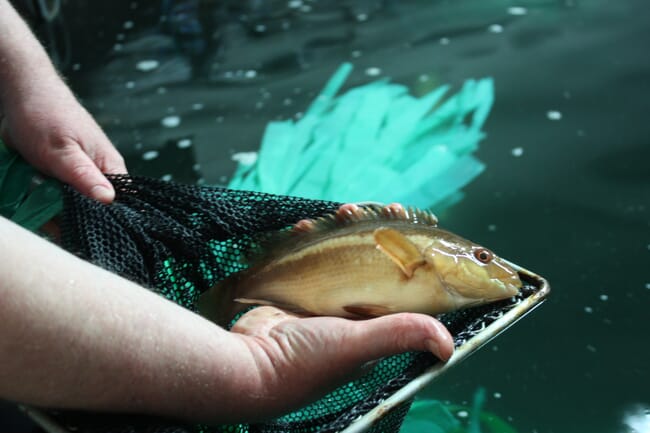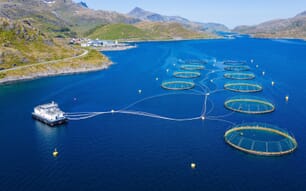Cleanerfish are stocked in marine cages to eat lice off the salmon but the parasites are more like ‘snacks’ and do not contribute enough nutrition to support them. The new project aims to acquire knowledge of the correct feed and nutrition needed to sustain the cleanerfish and optimize their efficacy as eaters of sea lice.

© Rob Fletcherfish/articles/ballan-wrasse-credit-rob-fletcher.JPG
“The objective for the aquaculture industry is to become self-sufficient in cultivated cleanerfish, and so it is necessary to know how we should feed cleanerfish so that they survive and can be efficient lice-eaters,” says Ingrid Lein, from Nofima, who is leading the research.
Financed by the Norwegian Seafood Research Fund (FHF), the 4-year ‘CleanFeed’ project involves researchers from Nofima, NIFES, the NMBU School of Veterinary Science and NTNU Ålesund. Lumpfish (Cyclopterus lumpus) and ballan wrasse (Labrus bergylta) are the two cleanerfish the industry is cultivating, so research efforts will be concentrated on these two species. Lumpfish and ballan wrasse have quite different physiology, behaviour and characteristics. The industry expectation is for both species to be robust, have low mortality and a solid health and nutritional status, in order to thrive in the salmon nets and do their job as lice eaters.
“The fish must receive the proper feed if we are to achieve this,” says Lein.
Nutrient balance
The first trials in the project will examine the need for nutrients of both species. The first trial will address what the optimal balance of primary nutrients is for lumpfish. The next step is to investigate the need for micro-nutrients - ie minerals and vitamins. The need for nutrients varies according to factors such as size of the fish, temperature, growth speed and stress. It is therefore impossible to define one need that will apply to all situations.
“In this project, we will find the optimal composition of feed for the sizes of lumpfish and ballan wrasse concerned. Because the two species are so different to begin with, it is necessary to develop feed that is suitable for each individual species,” says Øystein Sæle at NIFES.
Combating cataracts
Experience from cultivated lumpfish shows that they can often develop cataracts, so that sight in the fish is diminished. Good sight is especially important to the cleaner fish so they are able to graze efficiently on the lice that are attached to the salmon. Scientists will investigate whether there is a connection between feed and the development of cataracts. A probable candidate is the amino acid histidine, which is important for osmoregulation and other processes in the lens.
Similar to good sight, good intestinal function is important for good health and well-being.
“The intestines are actually a very important part of the immune system, and function as a barrier between the fish’s insides and possible outer impacts from feed and water,” says Åshild Krogdahl at NMBU. In the project, the NMBU School of Veterinary Science will investigate how changes in the composition of feed can affect intestinal function and health.

© Rob Fletcher
Raw materials
Knowledge about the composition of nutrients is the starting point for making feed, but what raw materials should be used?
Ballan wrasse have proven to be very picky with respect to taste, especially in the beginning phase. Today, feed is made for ballan wrasse using high quality ingredients that are really made for human use, such as shrimp and krill oil.
“We will test more relevant raw ingredients for ballan wrasse; aquatic, vegetable and animal raw ingredients, and preferably downstream processed residues. It is important to find raw ingredients that can be combined in the correct mix, and that result in good survival and growth, and good well-being and health for the fish,” says Katerina Kousoulaki at Nofima.
Lumpfish are in many ways the opposite of the ballan wrasse. Lumpfish eat most of what they are given, and can grow remarkably fast, from the fry stage and onwards. This is not necessarily good; rapid growth requires more feed, and a lack of certain nutrients can more easily occur.
A question of temperature
In order for the cleaner fish to do the job of keeping the salmon free of lice, it is important that their nutritional needs are met and that they are in good condition. They must be fed in the cages, so it may be necessary to adapt both feeding and the consistency of the feed to each individual species.
From the starting point, ballan wrasse are better lice-eaters than lumpfish, and begin rapidly to graze on the lice once they have been placed in the cages, but they thrive best in relatively high temperatures. If they are healthy and in good condition, ballan wrasse can also function as cleaner fish in lower temperatures. Lumpfish thrive in low temperatures and therefore are more used than ballan wrasse in the winter and further towards the north where the water is colder.
High mortality rates for cleaner fish in the cages are often reported. This is a problem that scientists participating in CleanFeed hope to solve.
“The objective is for cleaner fish, preferably a combination of lumpfish and ballan wrasse, to be in the cage with the salmon throughout an entire production cycle. One of the prerequisites for this is without doubt good nutrition for the cleanerfish. We are looking forward to obtaining results in this project over the next four years,” says Lein.



